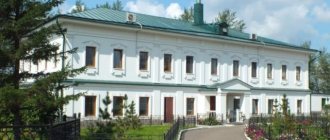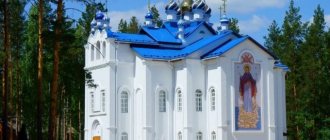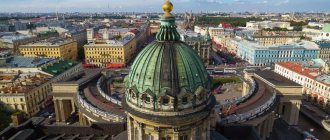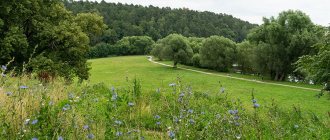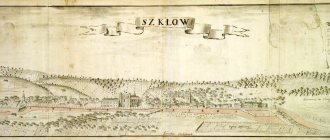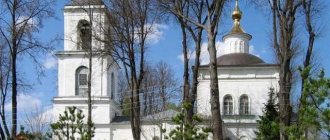Mir
Russia Yaroslavl Region Yaroslavl Convent of the Kazan Icon of the Mother of God (Yaroslavl) Map is loading…
{"format":"leaflet","minzoom":false,"maxzoom":false,"limit":50,"offset":0,"link":"all","sort":[""], "order":[],"headers":"show","mainlabel":"","intro":"","outro":"","searchlabel":"\u2026 \u0441\u043b\u0435\ u0434\u0443\u044e\u0449\u0438\u0435 \u0440\u0435\u0437\u0443\u043b\u044c\u0442\u0430\u0442\u044b","default":"","import-annotation":false,"width ":"auto","height":"350px","centre":{"text":"","title":"""link":"""lat":57.6282860000000027866917662322521209716796875,"lon": 39.88709899999999919373294687829911708831787109375,"icon":""},"title":"","label":"","icon":"","lines":[],"polygons":[],"circles":[ ],"rectangles":[],"copycoords":false,"static":false,"zoom":8,"defzoom":14,"layers":["OpenStreetMap"],"image layers":[] ,"overlays":[],"resizable":false,"fullscreen":true,"scrollwheelzoom":true,"cluster":false,"clustermaxzoom":9,"clusterzoomonclick":true,"clustermaxradius":80, "clusterspiderfy":true,"geojson":"","clicktarget":"","showtitle":true,"hidenamespace":false,"template":"","userparam":"","activeicon": "","pagelabel":false,"ajaxcoordproperty":"","ajaxquery":"","locations":[{"text":"\u003Cb\u003E\u003Ca href=\"/palomnik/%D0% 96%D0%B5%D0%BD%D1%81%D0%BA%D0%B8%D0%B9_%D0%BC%D0%BE%D0%BD%D0%B0%D1%81%D1%82% D1%8B%D1%80%D1%8C_%D0%9A%D0%B0%D0%B7%D0%B0%D0%BD%D1%81%D0%BA%D0%BE%D0%B9_%D0% B8%D0%BA%D0%BE%D0%BD%D1%8B_%D0%91%D0%BE%D0%B6%D0%B8%D0%B5%D0%B9_%D0%9C%D0%B0% D1%82%D0%B5%D1%80%D0%B8_(%D0%AF%D1%80%D0%BE%D1%81%D0%BB%D0%B0%D0%B2%D0%BB%D1 %8C)\» title=\»\u0416\u0435\u043d\u0441\u043a\u0438\u0439 \u043c\u043e\u043d\u0430\u0441\u0442\u044b\u0440\u044c \u041a\u0430\u04 37\u0430\ u043d\u0441\u043a\u043e\u0439 \u0438\u043a\u043e\u043d\u044b \u0411\u043e\u0436\u0438\u0435\u0439 \u041c\u0430\u0442\u0435\u 0440\u0438 (\u042f\u0440\u043e \u0441\u043b\u0430\u0432\u043b\u044c)\»\u003E\u0416\u0435\u043d\u0441\u043a\u0438\u0439 \u043c\u043e\u043d\u0430\u0441\u044 2\u044b\u0440\u044c\ u041a\u0430\u0437\u0430\u043d\u0441\u043a\u043e\u0439 \u0438\u043a\u043e\u043d\u044b \u0411\u043e\u0436\u0438\u0435\u0439 \u 041c\u0430\u0442\u0435\u0440\ u0438 (\u042f\u0440\u043e\u0441\u043b\u0430\u0432\u043b\u044c)\u003C/a\u003E\u003C/b\u003E\u003Chr /\u003E\u003Ca href=\»/palomnik/%D0% A1%D0%B2%D0%BE%D0%B9%D1%81%D1%82%D0%B2%D0%BE:%D0%90%D0%BD%D0%BD%D0%BE%D1%82 %D0%B0%D1%86%D0%B8%D1%8F\" title=\"\u0421\u0432\u043e\u0439\u0441\u0442\u0432\u043e:\u0410\u043d\u043d\u043e\u0442\ u0430\u0446\u0438\u044f\»\u003E\u0410\u043d\u043d\u043e\u0442\u0430\u0446\u0438\u044f\u003C/a\u003E: »'\u041c\u043e\u043d\u0 430\u0441\u0442 \u044b\u0440\u044c \u041a\u0430\u0437\u0430\u043d\u0441\u043a\u043e\u0439 \u0438\u043a\u043e\u043d\u044b \u0411\u043e\u0436 \u0438\u0435\u0439 \u041c\u0430 "" 430\u043c\u044f\u0442\u044c\ u043e\u0447\u0443\u0434\u0435\u0441\u043d\u043e\u043c\u0438\u0437\u0431\u0430\u0432\u043b\u0435\u043d\u0438\u0438\u042f\u 0440\u043e\u0441\u043b\u0430\ u0432\u043b\u044f \u043e\u0442 24-\u0445 \u0434\u043d\u0435\u0432\u043d\u043e\u0439 \u043e\u0441\u0430\u0434\u044b \u043f\u0 43e\u043b\u044c\u0441\u043a\ u0438\u0445 \u0437\u0430\u0445\u0432\u0430\u0442\u0447\u0438\u043a\u043e\u0432","title":"\u0416\u0435\u043d\u0441\u043a\u0438\u04 39\u043c\u043e \u043d\u0430\u0441\u0442\u044b\u0440\u044c \u041a\u0430\u0437\u0430\u043d\u0441\u043a\u043e\u0439 \u0438\u043a\u043e\u043d\ u044b\u0411\u043e\u0436\u0438 \u0435\u0439 \u041c\u0430\u0442\u0435\u0440\u0438 (\u042f\u0440\u043e\u0441\u043b\u0430\u0432\u043b\u044c)","link":"","lat":57.6282 860000000027866917662322521209716796875 ,"lon":39.88709899999999919373294687829911708831787109375,"icon":""}],,"imageLayers":[]}
57.628284; 39.887292
Russia, Yaroslavl, Pervomaiskaya street, 19A
Yaroslavl, Yaroslavl region150000
Russia
Telephone.:
8 (4852) 72-77-51
Monastery of the Kazan Icon of the Mother of God
founded in 1610 in memory of the miraculous deliverance of Yaroslavl from a 24-day siege of Polish invaders.
History[[edit]h2>
The history of the Kazan Monastery is connected with the discovery of the Yaroslavl-Kazan Icon of the Blessed Virgin Mary. This shrine was one of the first copies of the Kazan Icon, found in 1579 in Kazan.
The icon was originally brought in 1588 to the city of Romanov (now on the left bank of Tutaev) by a resident of this city, Gerasim, who received healing of his hand in Kazan. He was there on trade business and received in a vision a command from the Mother of God to purchase an icon of Her in a certain shop, bring it to Romanov and build a temple in honor of it. Many miracles and healings occurred from the newfound shrine. In March 1609, Romanov was devastated by Polish-Lithuanian invaders. Among them was one Litvin of the Orthodox confession, Yakov Lyubskaya. He took the icon of the Mother of God and later brought it to Yaroslavl. The city suffered greatly from the invaders acting on behalf of False Demetrius, many residents died, lost relatives and property. Having learned about the presence of the Kazan Icon in Yaroslavl, they began to ask Lyubsky to sell the shrine, but he refused. Then he gave the icon away for free. Yaroslavl residents placed the image in the Church of the Praise of the Mother of God of the Dimitrievsky parish. The enemies left the city in May 1609. At the same time, the deacon of the Church of the Exaltation of the Cross, Eleazar, had a revelation from the Mother of God, who commanded that the townspeople and service people erect a temple in honor of the miraculous image. At the expense of the inhabitants, the temple was built in gratitude for deliverance from the invaders. Before the consecration of the temple, the Yaroslavl-Kazan Icon of the Mother of God was solemnly brought into its walls. Soon, 72 nuns from the Nativity monastery, which had been devastated by enemies, settled at the temple. Thus was laid the foundation of the Kazan convent and the veneration of the miraculous icon.
Two religious processions a year were held with the miraculous image of the Yaroslavl-Kazan Icon of the Mother of God. Since 1761, in June, the image was brought to the city of Romanov. The icon walked along the left bank of the Volga, in Romanov it was placed in the Transfiguration-Kazan Church, where it remained for three weeks, after which it was transported to the right bank, to the Resurrection Cathedral. Two weeks later the icon was sent to Yaroslavl along the right bank of the Volga. The second religious procession since 1800 went to Rybinsk in July, after the patronal feast of the monastery. The icon stayed there for seven weeks. To Rybinsk the religious procession went along the right bank of the Volga, and back along the left.
The Kazan monastery suffered many destructions and a period of desolation in the 20th century, sharing the fate of many Russian monasteries. In 1918, during the suppression of the anti-Bolshevik uprising, the monastery suffered significant destruction. It was closed that same year. Abbess Theodotia and her sisters moved to the Tolga Monastery, which was still in operation. In 1920-21, one of the Yaroslavl concentration camps was located in the monastery buildings.
For some time, the Intercession Church acted as a parish church. It preserved the main shrines of the monastery - the Yaroslavl-Kazan Icon of the Mother of God, the Icon of the Savior Uncreated and the Three-Handed One. After the closure of the temple, the community was transferred to the Church of the Exaltation of the Cross, where the shrines were also moved. In 1931, this parish was liquidated; the fate of the shrines, including the Yaroslavl-Kazan Icon, is unknown. Only the pictorial frame of the miraculous image has been preserved; it is on display in the ancient Russian department of the Yaroslavl Art Museum.
Life of the monastery
At first the monastery was made entirely of wood. Only in 1649 was a stone church built, and in 1658 a massive fire burned down everything wooden: residential buildings, work services. The stone temple itself was significantly damaged by fire.
Through the efforts of the townspeople and the zeal of Moscow, the temple and monastery were restored. Tsar Alexei Mikhailovich even established a salary for each old woman - 1 ruble per year. In 1710, the number of nuns was already 132, and the monastery and temple itself, through labor and gifts, acquired church utensils, bells, icons were painted and brought from other places, and the territory with services was being developed. At this time, the charter of the monastery was not yet a cenobitic type: all the elders lived exclusively on their own income - only in 1802 the monastery became a cenobitic one.
Current state[[edit]h2>
In the early 1990s, the Kazan Cathedral, which had not yet been returned to the Church, was gradually, one after another, crowned with five gilded domes. In 1997, the liturgical life of the monastery was resumed. The cathedral was opened as a parish church. Divine services were held in the basement. In 1998, the monastery was opened 80 years after its closure. In the same year, the Sretenskaya house church was transferred and began to be restored. The surviving buildings, inhabited by residents, were transferred gradually over several years. In 1999, the archive storage was transferred to Rybinsk, and the Kazan Cathedral was vacated. Its long and painstaking reconstruction began. Nowadays, the cathedral iconostasis is being restored.
For the millennium of Yaroslavl, a new planetarium was built, and the Church of the Intercession was returned to the monastery. Work is now underway to restore it. On the territory of the monastery there is the Yaroslavl provincial gymnasium named after St. Ignatius Brianchaninov and the Regency School at the Yaroslavl Theological Seminary. In 2003, on the territory of the Kazan Monastery, in front of the cathedral, a memorial cross “To the victims of the bloody events in the summer of 1918 from the Nativity of Christ” was erected.
The tradition of religious processions with the Kazan Icon has been restored these days. Every year in July, a multi-day religious procession takes place along the left Volga bank through the left bank Tutaev (Romanov) to Rybinsk, and back along the right bank through the right bank Tutaev (Borisoglebsk) to Yaroslavl. The procession makes stops in many temples and villages.
Description of the architecture
The Kazan Cathedral is the main church of the courtyard; it was created by the architect Abraham Melnikov, who was also the rector of the Academy of Arts. It was he who created the architectural design of the future temple in the exact stylistic features of late classicism. That is why porticoes with columns in strict forms are attached to its quadrangle.
The volume of the building is given by 5 drums, each of which is topped with golden onion-heads. Initially, the temple was decorated with a high bell tower, but it was destroyed by the Soviet authorities.
The cathedral building is very massive; all entrances and piers, as well as chapters, are decorated with columns and semi-columns, which look like octagonal towers. Inside the temple there is an iconostasis in three tiers, decorated with skillful carvings.
Interior of the Kazan Cathedral
The Intercession Church, which was warm, was built in 1820-1830. The foundation stones were laid by the abbess of the monastery at that time, Margarita, and Archbishop Abraham. This happened on one of the days of the procession and was witnessed by many believers. This temple has two chapels.
Another church on the territory of the courtyard, Sretenskaya, was erected in the late 70s - early 80s of the 19th century. Abbess Feofania sponsored the construction. The built church was a home for all future abbess.
Stone monastery, human image
By the end of the 18th century, not only the wooden buildings of the monastery had become dilapidated and dilapidated, but also the stone ones: even the stone fence was “overgrown with trees” and was ready to fall.
Therefore, long (the monastery is not rich), but large-scale reconstruction in stone begins. From 1770 to the middle of the 19th century, almost every building of the monastery was updated - the cell buildings, the fence, which was erected in the old way with towers in the corners. New churches were built - Pokrovskaya and Sretenskaya.
The temple was also rebuilt under the supervision of the provincial architect P. Pankov according to the design of the architect Melnikov. The consecration of the temple in the name of the Kazan Icon of the Mother of God took place in 1845. The cathedral with its austere, majestic appearance, octagonal dome towers, dry, monotonous rhythm of the colonnades is a monument to the era of late classicism. The cathedral was painted by Medvedev's artel.
The area of the monastery in its best years was equal to an entire block, the boundaries of which were the current streets of Trefoleva, Pervomaiskaya and Volkova Square (formerly Teatralnaya). The city treasury paid 337 rubles and 42 kopecks per year for the maintenance of the monastery and the sisters' salaries.
However, the monastery was not in poverty: a variety of prosphora were expertly baked there, and an icon-painting and gold-embroidery workshop operated there. The latter's products were so magnificent that they were sent to the World Exhibition in Paris and received a diploma. Another glory of the monastery was the choir, numbering up to 200 people.
They also opened a school at the monastery, where 63 girls were taught at the beginning of the 20th century.
The year 1910 became special for the monastery in many ways. The monastery celebrated 300 years from the year of its creation, and the anniversary service was conducted by Archbishop Tikhon of Yaroslavl and Rostov, the future patriarch.
New time
1918 - the monastery was abolished, the elders were sent to the Tolgsky monastery, property was expropriated, the miraculous image was lost...;
1919 - 1922 - the monastery was turned into a concentration camp;
1928 - the State Archive of the Yaroslavl Region was housed in the cathedral;
1930 - to the present day - a library is located in the Church of the Intercession, and then a planetarium and a college;
1988 - the monastery was restored to its status.
As soon as the monastery was opened, he was given a new copy of the miraculous icon, made by the nuns just before the closure. As if anticipating a time of need, the elders preserved a miraculous face for the church and parish, for the city, which inspired the Yaroslavl people to victory.
In 2000, the relics of St. Agathangel, who was canonized as Russian saints and new martyrs, were transferred to the monastery. Later, divine services in the cathedral resumed, in 2002 a religious procession began, and in 2006, education began at the first Orthodox gymnasium, named in honor of Ignatius Brenchaninov. Classes in the gymnasium are conducted in both secular and Orthodox sciences, and the teachers are priests, doctors and candidates of various sciences, specialists in various fields of knowledge.
Now, at the revived and functioning monastery, a regency school has been opened for the education of regents, registrants and psalmists for the needs of the dioceses of Yaroslavl and other cities.
Address: Yaroslavl, st. Pervomayskaya, 19-a.
Official website: https://Kazan-nunnery-monastery.rf/
Location map:
| ← Church of the Presentation of the Lord in Deputatsky Lane | Church of the Epiphany → |
How to get there
Address of the monastery: Yaroslavl, Bogoyavlenskaya Square, 25. The monastery is located in the Kirovsky district on the bank of the Kotorosl River, next to the Moscow Bridge.
If you travel from Moscow by your own car, you should take the M8 highway. Within the city it is called Moskovsky Prospekt. The monastery courtyard is located on the right side of the street.
It is also convenient to get from the capital by train. Express trains arrive in 3 hours, a regular train takes a little longer - up to 5 hours. From the Moskovsky railway station in Yaroslavl you can walk to the monastery, the distance is only 2.5 km.
Architectural monuments and attractions
The main pearl of this place is the Transfiguration Cathedral, which is one of the oldest architectural monuments in this region. Historians believe that this building became a kind of laying of the foundations of the Yaroslavl architectural school.
Paintings of the altar of the Transfiguration Cathedral
Of no less interest are the preserved watchtowers, the refectory and the holy gates. In the courtyard of the monastery, decorative beehives were installed near the Yaroslavl Wonderworkers Church in the form of a hut, a church and a Russian tower. Also on the territory there are monuments to Prince Pozharsky and a kopek of 1612 - this coin contains the personal inscription of the last representative of the Rurik dynasty who was on the throne - Fyodor Ioannovich.
Opposite the abbot’s chambers, the bear Masha lives in an enclosure. In the warm season it is very green and cozy here.
Visiting mode
Entrance for visitors is paid. You can just come and take a look any day. Exhibition halls are closed on Mondays. The Nature Department is closed on Thursdays. Tuesday is a day off for “Treasures of Yaroslavl”.
From October to April, you can enter the territory of the museum-reserve from 9:00 to 18:00. The exhibit halls open from 10:00 and are open until 17:30. Those wishing to admire the surrounding views can climb the belfry from 8:30 to 19:30.
In the summer (from May to the end of September), the hours for visiting exhibition halls do not change, and you can stay on site for two hours longer - until 20:00. Every first Wednesday of the month there is a sanitary day.
Yaroslavl. Spaso-Preobrazhensky Monastery
What to see nearby
- The Art Museum was founded in 1919. The collection was formed from receipts from other Russian museums, confiscated paintings, and paintings were donated from artists and individuals. Today the museum's collection consists of more than 70 thousand exhibits. These are mainly works of Russian masters. The collection is displayed in several buildings. Most of the works can be seen in the building of the Governor's House.
- The Governor's Garden appeared in Yaroslavl at the beginning of the 19th century. It is located not far from the monastery, only 500 m. Two Russian emperors visited this park - Nicholas II and Alexander I. The small picturesque park has preserved the atmosphere of past centuries, peace and tranquility reign here. Well-groomed territory, sculptures, landscape design, colorful flower beds - the garden is a great place for walks. According to tourists, it is best to visit the park in the summer, when concerts and other cultural events are held there.
- The Gingerbread Museum is located 500 m from the monastery. In the museum you can learn the history, technology, and secrets of making gingerbread from various Russian regions. Tastings and master classes are held. The souvenir shop sells more than 10 types of these products.
The Kazan Monastery attracts tourists and believers. If the former are interested in history and the architect, then the latter visit the monastery for the sake of Orthodox shrines. Thousands of pilgrims visit the monastery to pray to the icon of Our Lady of Kazan and attend services.
Russian Drama Theater named after F. Volkov
This is the oldest drama theater in Russia. It began its theatrical history as a tannery barn, which hosted amateur productions by the talented F.G. Volkov, in which he involved his family and friends. 1750 is considered the year of its foundation, since it was then that the first performance took place. A special building appeared in 1951, then a new building was added towards the end of the 19th century. By this century, the drama theater became famous throughout Russia. Later, a competition was even announced for the best design of a new building among architects. And in 1911, the building designed by Nikolai Spirin appeared - this is how it has been preserved to this day.
Memorial House-Museum of L. V. Sobinov
In a small mansion in Yaroslavl in 1872, the future luminary of the Russian opera stage, Leonid Vasilyevich Sobinov, was born into the family of a trade employee. Opera lovers called Sobinov the “first tenor” of Russia, who glorified the Russian opera school and became one of the famous opera singers of the world classics.
Museum visitors can view photographs of opera roles created on stage by the famous singer, his stage costumes, a set of theatrical accessories used by the singer, his personal belongings and documents. Yaroslavl residents are proud of their fellow countryman, who created the stage image of Vladimir Lensky in the opera “Eugene Onegin,” which is still considered the best and unsurpassed.
The Department of Culture of the Yaroslavl Region named the Yaroslavl Music School after L.V. Sobinova. The street on which Sobinov’s house-museum is located is named after him.
Address: Sobinova street, 25.
